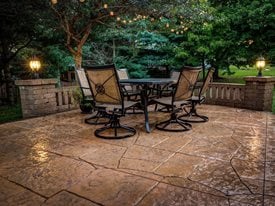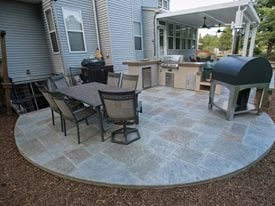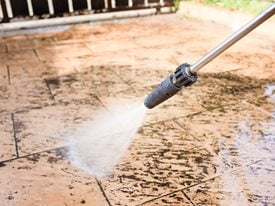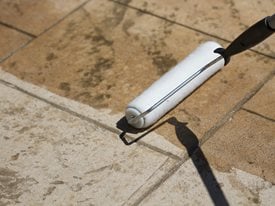
This patio was sealed with a wet look sealer. J&H Decorative Concrete LLC in Uniontown, OH.
A good concrete patio sealer keeps new surfaces looking great for many years to come and improves the appearance of existing patios, especially if they are topically colored. If sealing isn’t already a routine part of your concrete patio maintenance plan, here’s what you need to know to get started.
Do I Need to Seal My Concrete Patio?
Even though concrete patios aren’t exposed to vehicle traffic or deicing salts, like concrete driveways are, they still take plenty of punishment. Backyard barbecues, outdoor campfires, heavy foot traffic, and unrelenting sunshine can cause patios to fade, discolor, and abrade if you leave them unprotected.
Find concrete patio contractors near me.
The reasons for sealing a concrete patio are similar to those for waxing a car, wearing sunscreen, or applying stain repellent to new carpeting. It’s done to enhance the appearance, keep the color from fading due to sun exposure, and protect it from stains and moisture absorption.
If your patio is located in a region of the country subject to freeze-thaw cycles, applying sealer will reduce the chance of freeze-thaw damage - the ugly surface spalling and scaling that can occur after water is absorbed into concrete and expands when it freezes. Although concrete patios aren’t typically exposed to deicing salts, which can aggravate the problem, they are still porous and will absorb water if left unsealed.
For stamped concrete patios, which are typically enhanced by surface-applied color (see Options for Coloring Stamped Concrete) a sealer will help prevent the color from fading over time due to sun exposure, foot traffic, and abrasion. Sealers will also help prevent discoloration caused by common outdoor stains such as dirt, leaves, lawn chemicals, food spills, and residue from fire pits. Many concrete sealers intended for outdoor use contain UV protectants and stain repellents that will virtually eliminate fading and make the concrete easier to clean and maintain.
What is the Best Concrete Sealer for Patios?
The primary type of sealer used on decorative concrete patios and other exterior flatwork is a solvent- or water-based acrylic. Acrylic sealers are easy to apply, economical, and well-suited for outdoor use because they are UV resistant, non-yellowing and breathable, which means they provide good water repellence while allowing moisture vapor within the slab to escape.

This patio was sealed with a custom-blended zero-shine sealer to give it a matte finish.
If you don't want a sheen on the patio surface and prefer a natural look, a penetrating sealer is an alternative that provides good protection against outdoor exposure conditions without forming a surface film.
The first and most important consideration when choosing a sealer is whether the product is compatible with the decorative concrete patio surface you plan to apply it to. The type of finish you want to achieve (such as matte vs. high gloss) comes in a close second. See other important factors you should evaluate when choosing a sealer appropriate for your project and budget.
How Do Sealers Improve Patio Appearance?
In addition to protecting colored concrete patios from fading, a sealer can also enhance and intensify the color. Depending on the type of sealer you apply, your options range from a natural matte finish to a high-gloss sheen.
Chemically reactive sealers are nearly invisible because they penetrate into the concrete, making them great choices for concrete patios that are stamped to replicate weathered stone. Water-based acrylic resin sealers will provide greater color enhancement and a low-gloss satin finish. And solvent-based acrylic sealers and epoxies will give concrete a high-gloss wet look and significantly deepen the color. There are also sealers specifically formulated to enhance the beauty of natural stone in exposed aggregate concrete (see Exposed Aggregate Sealers).
Here are several examples of stamped and stained concrete patios that were enhanced by the application of a sealer:
Patio Showcases the Beauty of Natural Gray
Beautiful Chemistry
Concrete Patio Showcases Creative Staining
Tiered Concrete Patio Mimics Grouted Stone






